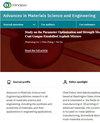Comparative Study of Mortars Made with Sands of Different Geological Origin
4区 材料科学
Q2 Engineering
引用次数: 0
Abstract
The present work is a comparative study of sand mortars from various geological origins to highlight their influence on mortar qualities. Five different sands and the cement CEM II/B–P 42.5R were used to produce mortars with similar water/cement ratios (W/C). These are the “Sanaga” sand from the Sanaga River, the “Wouri” sand from the Wouri River, the Nyambaka basalt sand, the Meiganga granite sand, and the Leboudi gneiss sand. The physical, chemical, and mineralogical features of these sands were used to characterize and classify them. They were then used to formulate mortars, which were analyzed and compared. According to the results of the mortar setting time tests, the initial setting time ranges from 195 minutes for Sanaga sand mortar (MS04) to 210 minutes for gneiss sand mortar (MGN03), passing Wouri sand mortar (MW05) with 200 minutes, basalt sand mortar (MB01) with 198 minutes, and granite sand mortar (MGR02) with 196 minutes. The final setting time ranged from 496 minutes (MGR02) to 510 minutes (MGN03), with an average of 300 minutes added to the initial setting time. The flexural strength tests of the mortars reveal that crushed sands outperform alluvial sands. They range from 1.64 to 2.18 MPa after 2 days, 3 to 3.90 MPa after 7 days, and 7 to 14.84 MPa after 28 days. The results of the compressive strength tests show that quarry sand mortars have greater average compressive strengths than alluvial sand mortars, with basalt sand providing the greatest performance. These strengths range from 6.35 to 10.83 MPa after 2 days, 7.55 to 18.96 MPa after 7 days, and 22.81 to 34.58 MPa after 28 days, with the MB01 being the best sand. These findings reveal that the geological origin of sands, which specifies certain of their physicochemical and mineralogical attributes, has an impact on the properties of mortars. This impact is also influenced by granulometry and organic matter concentration.不同地质来源砂制砂浆的比较研究
本文对不同地质来源的砂砂浆进行了对比研究,以突出其对砂浆质量的影响。使用5种不同的砂和水泥CEM II/ B-P 42.5R,生产出具有相似水灰比(W/C)的砂浆。这些是来自萨纳加河的“萨纳加”沙,来自Wouri河的“Wouri”沙,尼亚姆巴卡玄武岩沙,梅甘加花岗岩沙和勒布迪片麻岩沙。这些砂的物理、化学和矿物学特征被用来表征和分类。然后将它们用于配制迫击炮,并对其进行分析和比较。根据砂浆凝结时间试验结果,砂那加砂砂浆(MS04)初始凝结时间为195分钟,片麻岩砂砂浆(MGN03)初始凝结时间为210分钟,通过武日砂砂浆(MW05) 200分钟,玄武岩砂砂浆(MB01) 198分钟,花岗岩砂砂浆(MGR02) 196分钟。终凝时间范围为496 min (MGR02) ~ 510 min (MGN03),初凝时间平均增加300 min。砂浆的抗折强度试验表明,破碎砂优于冲积砂。2 d后为1.64 ~ 2.18 MPa, 7 d后为3 ~ 3.90 MPa, 28 d后为7 ~ 14.84 MPa。抗压强度试验结果表明,采石砂砂浆比冲积砂砂浆具有更高的平均抗压强度,其中玄武岩砂性能最好。2 d后强度范围为6.35 ~ 10.83 MPa, 7 d后强度范围为7.55 ~ 18.96 MPa, 28 d后强度范围为22.81 ~ 34.58 MPa, MB01为最佳。这些发现表明,砂的地质成因,规定了砂的某些物理化学和矿物学属性,对砂浆的性质有影响。这种影响还受到粒度和有机物浓度的影响。
本文章由计算机程序翻译,如有差异,请以英文原文为准。
求助全文
约1分钟内获得全文
求助全文
来源期刊

Advances in Materials Science and Engineering
Materials Science-General Materials Science
CiteScore
3.30
自引率
0.00%
发文量
0
审稿时长
4-8 weeks
期刊介绍:
Advances in Materials Science and Engineering is a broad scope journal that publishes articles in all areas of materials science and engineering including, but not limited to:
-Chemistry and fundamental properties of matter
-Material synthesis, fabrication, manufacture, and processing
-Magnetic, electrical, thermal, and optical properties of materials
-Strength, durability, and mechanical behaviour of materials
-Consideration of materials in structural design, modelling, and engineering
-Green and renewable materials, and consideration of materials’ life cycles
-Materials in specialist applications (such as medicine, energy, aerospace, and nanotechnology)
 求助内容:
求助内容: 应助结果提醒方式:
应助结果提醒方式:


